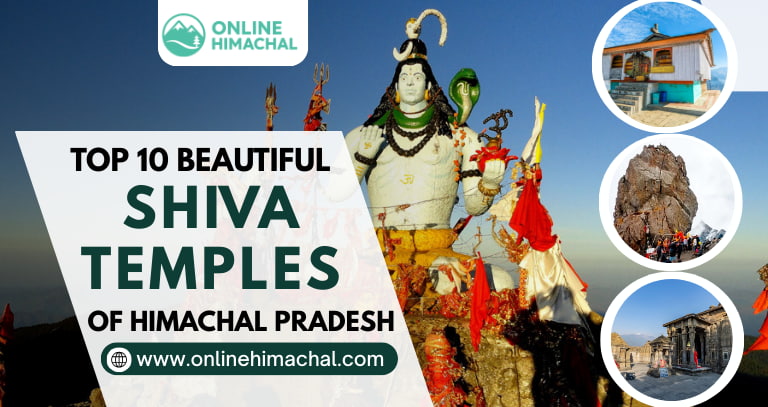Himachal Pradesh, known as the “Land of the Gods,” has numerous ancient and beautiful temples. Among them, the Shiva Temples of Himachal Pradesh are significant to many travelers and devotees. These temples offer a special experience in terms of history and spirituality. Situated in peaceful mountain villages, near rivers, or high on hilltops, each temple has a remarkable story and charm. Therefore, whether you are a devotee of Lord Shiva or someone who enjoys cultural, religious, or spiritual places, the temples of Himachal Pradesh will provide a remarkable and beautiful experience that you will never forget. Moreover, the natural beauty around them makes the visit even more memorable.
Through this comprehensive blog, let’s have a look at top 10 most beautiful Shiva temples in Himachal Pradesh that you must visit at least once.
Table of Contents
List of Top 10 Shiva Temples of Himachal Pradesh That You Must Visit
Himachal Pradesh is home to many stunning Shiva temples, and each of them offers a combination of spiritual energy, ancient architecture, and breathtaking natural surroundings. These sacred sites invite both devotees and travelers to explore their beauty and history. Here’s a complete list of the most beautiful top 10 Shiva temples you must visit in Himachal Pradesh.
1. Manimahesh Temple, Chamba
Manimahesh Temple is a prominent shrine of Shiva shrine situated at Bharmour in the Chamba district, near the sacred Manimahesh Lake. The temple is located below the Manimahesh Kailash Peak, which beautifully reflects in the lake. One of the reasons for its prominence is that devotees believe that Lord Shiva performed his cosmic, Tandava dance here. The temple site is about a 13 Km trek from the trek start point of Hadsar, which passes through waterfalls, meadows, and forests. It attracts thousands of devotees engaged in the Yatra from late August to late September every year. It is one of the most spiritually charged Shiva temples of Himachal Pradesh and is believed to bring blessings to those who take this journey with a pure heart and sincere devotion.
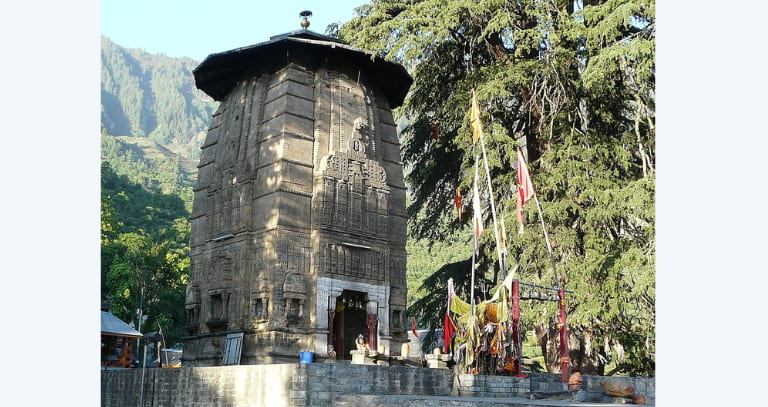
| Temple Name | Manimahesh Temple |
| Location (District) | Chamba (Bharmour) |
| Trek Distance | 13 km from Hadsar |
| Main Significance | Associated with Lord Shiva’s cosmic Tandava dance |
| Best Time to Visit | Aug–Sept (Manimahesh Yatra) |
2. Shrikhand Mahadev, Kullu
Shrikhand Mahadev Temple is one of the toughest temples of Shiva at an altitude of 5,155 meters in Kullu. This place is accessible after trekking nearly 35 km from the village of Jaon. It’s a steep trek that contains snow, rivers, and some lovely camping locations like Thachru and Bhim Dwar. This is where it is said Lord Shiva meditated. At the top is a naturally formed Shivling, where one can take in stunning views. The trek is said to be a test of faith, and only the most devoted make it to the top to pray for Lord Shiva’s blessings and inner strength.
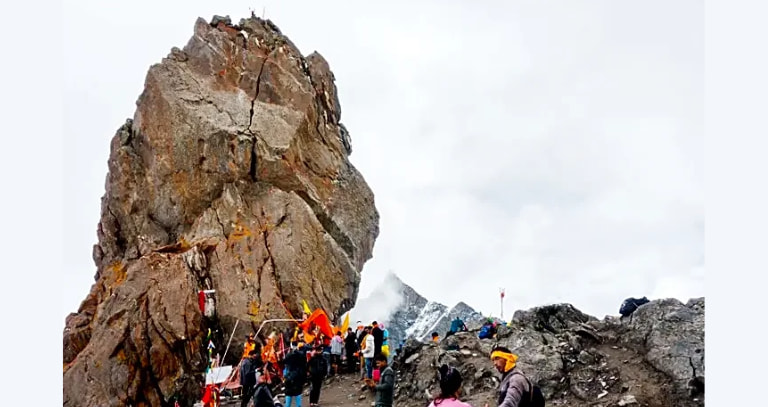
| Temple Name | Shrikhand Mahadev |
| Location (District) | Kullu (Jaon village) |
| Trek Distance | ~35 km steep trek |
| Main Significance | Lord Shiva meditated here; natural Shivling at the top |
| Altitude | 5,155 m |
| Best Time to Visit | July–Aug (Shrikhand Yatra) |
3. Baijnath Temple, Kangra
The Baijnath Temple is one of the most admired temples of Shiva in Himachal Pradesh, located in the Beas Valley in Kangra district. This temple, built in 1204 AD, is dedicated to Lord Shiva as Vaidyanath (the Lord of Healing). The ancient temple was constructed by two merchants, Ahuka and Manyuka. The water of the temple is believed to have healing qualities. The lingam is worshipped here with significant devotion. Moreover, the temple has amazing carvings and idols of other deities, and stunning gardens. It is a blend of sacredness and natural beauty, with the Himalaya mountains in the background. Also, it is believed that Ravana worshiped Lord Shiva at this site.
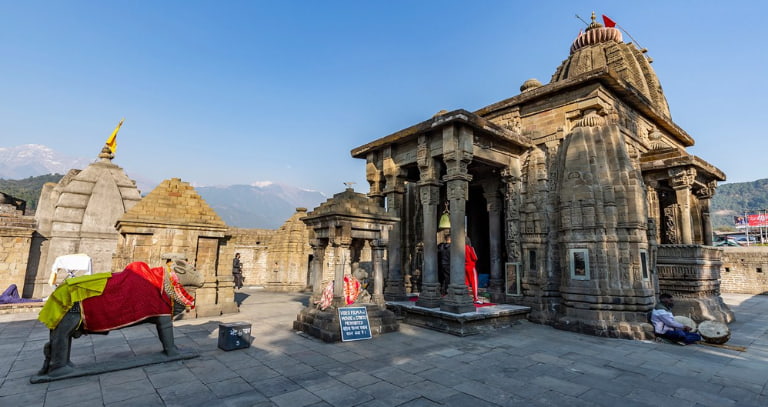
| Temple Name | Baijnath Temple |
| Location (District) | Kangra (Beas Valley) |
| Built In | 1204 AD |
| Main Significance | Dedicated to Lord Shiva as Vaidyanath (Lord of Healing) |
| Special Belief | Temple water has healing qualities; Ravana worshipped here |
| Best Time to Visit | March–June, Sept–Nov |
4. Baba Bhootnath Temple, Mandi
The Baba Bhootnath Temple is one of the most sacred Shiva temples in Himachal, located in Mandi, also called “Chhoti Kashi” for its many temples. This temple was built in 1527 by King Ajber Sen after a miracle happened: a cow’s milk would flow over a rock daily, and upon digging beneath it, a Shivling was found. The temple celebrates Lord Shiva in his fierce form as the Lord of Spirits. It attracts thousands of pilgrims, especially during Mahashivratri, when grand celebrations take place. The temple is known not only for its religious significance but also for the unique story connected to its origin.
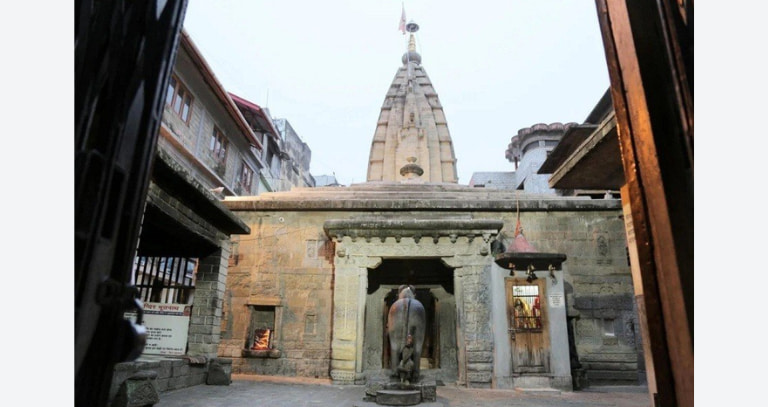
| Temple Name | Baba Bhootnath Temple |
| Location (District) | Mandi (“Chhoti Kashi”) |
| Built In | 1527 (by King Ajber Sen) |
| Main Significance | Dedicated to Lord Shiva in fierce form (Lord of Spirits) |
| Special Belief/Story | Shivling discovered after cow’s milk miracle |
| Best Time to Visit | Feb–March (Mahashivratri) |
5. Triloknath Temple, Purani Mandi
Triloknath Temple in Purani Mandi is one of the oldest and most respected Shiva temples of Himachal Pradesh. Built in 1520 by Queen Sultan Devi, the wife of Raja Ajber Sen, this temple features a rare stone idol of Lord Shiva with three faces. He is shown sitting with Goddess Parvati on the sacred Nandi bull. Inside the temple, there are also statues of Goddess Sharada and Sage Narada. The temple is adequately famous for its historic importance, spiritual atmosphere, and simple but graceful design. Also, this temple stands as a strong reminder of the faith and devotion of Mandi’s royal family towards Lord Shiva.
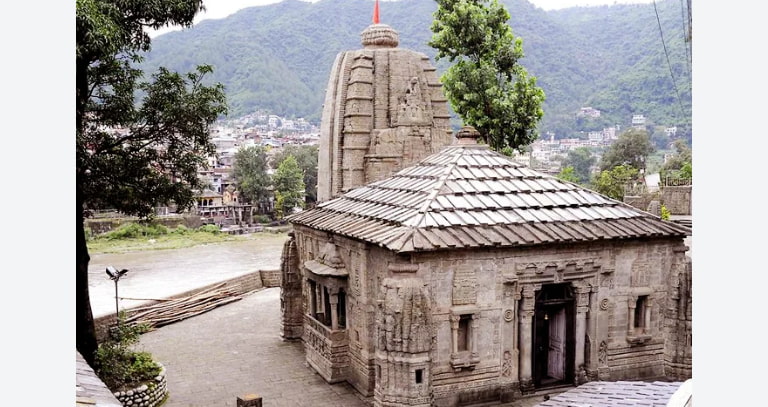
| Temple Name | Triloknath Temple |
| Location (District) | Purani Mandi |
| Built In | 1520 (by Queen Sultan Devi) |
| Main Significance | Ancient and respected Shiva temple |
| Unique Feature | Rare 3-faced idol of Lord Shiva with Goddess Parvati on Nandi |
| Best Time to Visit | March–June, Sept–Nov |
6. Bijli Mahadev Temple, Kullu
The Bijli Mahadev Temple, located high up in the Kullu Valley at 2,438 meters, is one of the most fascinating temples dedicated to Lord Shiva in Himachal Pradesh. The temple has a tall iron rod that is believed to attract lightning from the sky. Every time lightning strikes, the Shivling breaks into pieces and is restored using butter and ghee by the priests. This symbolizes nature’s cycle of destruction and renewal. A 2-3 km uphill trek is required to reach the temple. From the top, one can enjoy stunning views of the Parvati and Kullu valleys, which makes the spiritual journey totally worth the effort.
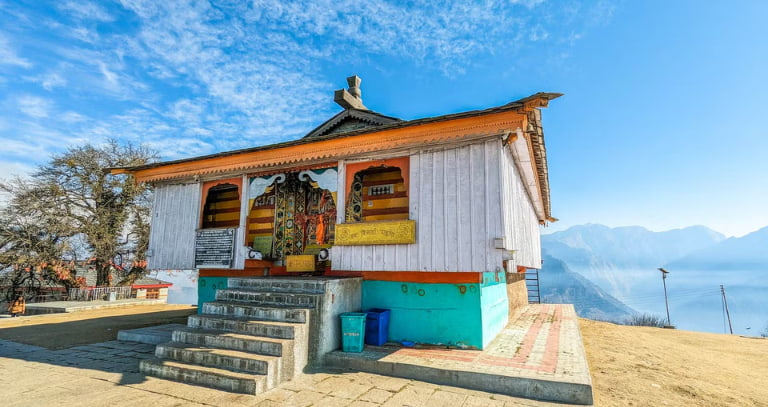
| Temple Name | Bijli Mahadev Temple |
| Location (District) | Kullu Valley |
| Altitude | 2,438 m |
| Trek Distance | 2–3 km uphill |
| Main Significance | Sacred Shiva temple with stunning valley views |
| Unique Feature | Lightning strikes break Shivling, restored with butter & ghee |
| Best Time to Visit | March–Sept |
7. Narvedeshwar Temple, Hamirpur
The Narvedeshwar Temple in Hamirpur was completed in 1802 by Rani Prasanna Devi (wife of King Sansar Chand). It was built with enchanting Bhitti-style architecture that captures attention. The murals on the walls depict various socially-relevant situations depicted from the Ramayana, Mahabharata, and Bhagavad Gita, along with other depictions of animals and birds. This temple is dedicated to Lord Shiva and Goddess Parvati, with other smaller shrines for Durga, Ganesha, and Lakshmi-Narayan. It is one of many culturally rich Shiva temples in Himachal Pradesh that reflect the local affinity for art and devotion.
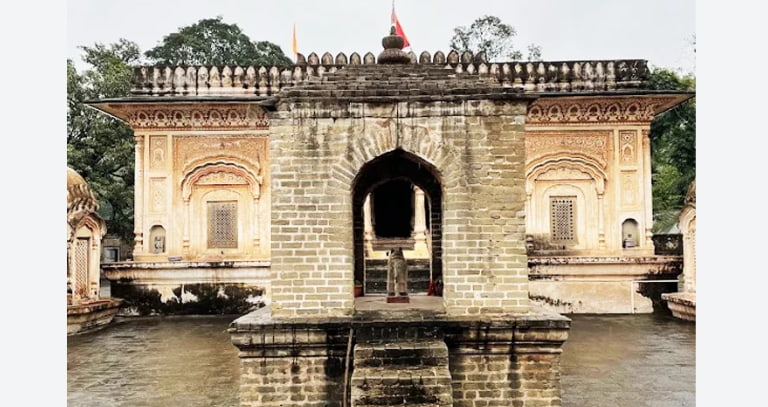
| Temple Name | Narvedeshwar Temple |
| Location (District) | Hamirpur |
| Built In | 1802 (by Rani Prasanna Devi) |
| Main Deities | Lord Shiva & Goddess Parvati |
| Unique Feature | Bhitti-style architecture, murals from epics & daily life |
| Best Time to Visit | Oct–March |
8. Panchvaktra Temple, Mandi
The Panchvaktra Temple is one of the most spiritually powerful Shiva temples of Himachal Pradesh, and is located at the meeting point of the Beas and Suketi rivers in Mandi. The name, Panchvaktra, means five faces, taken from the five-faced idol of Lord Shiva, which represents Shiva’s five aspects, which are known to have different meanings: Aghora, Ishana, Tatpurusha, Vamadeva, and Rudra. This temple consists of the shikhara style and is protected as a national heritage monument by the Archaeological Survey of India.
The temple is sometimes completely submerged during the monsoon, as the base is often flooded by the river. The temple’s location along the river, as well as its serenity, makes it a peaceful and significant location for devotees.
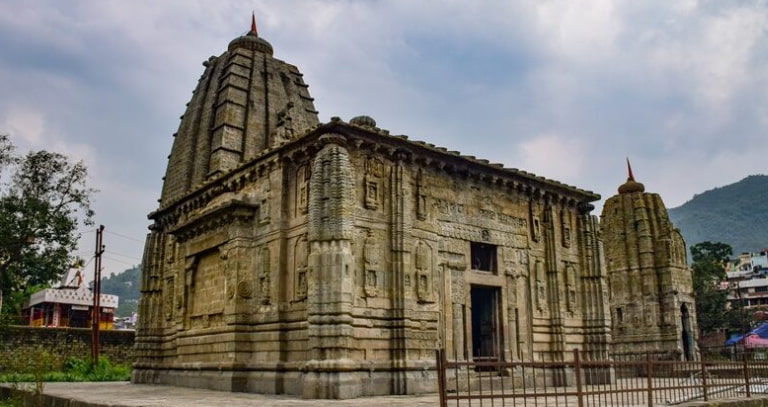
| Temple Name | Panchvaktra Temple |
| Location (District) | Mandi (Beas–Suketi confluence) |
| Architectural Style | Shikhara style |
| Main Significance | Five-faced idol of Lord Shiva representing 5 aspects |
| Unique Feature | Sometimes submerged during monsoon; ASI-protected monument |
| Best Time to Visit | Oct–June |
9. Bil-Kaleshwar Temple, Hamirpur
Located on the banks of the Beas River in Hamirpur, the Bil-Kaleshwar Temple is one of the historical Shiva temples of Himachal Pradesh. It is believed to be around 400 years old. According to local stories, the Pandavas began constructing this temple during their exile with the help of Lord Vishwakarma, but they had to leave it incomplete. A king from the Kaotch dynasty later completed it. Lord Shiva is worshipped here in the form of a Shivling. Many people who cannot reach Haridwar choose to immerse the ashes of their loved ones in the river beside this temple. The peaceful location adds to its spiritual charm.
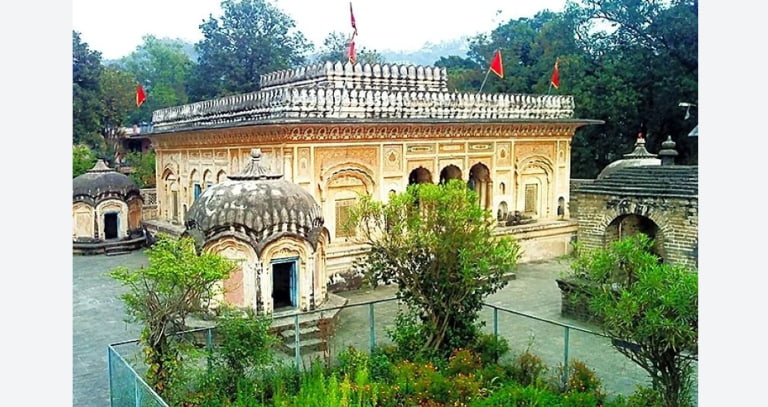
| Temple Name | Bil-Kaleshwar Temple |
| Location (District) | Hamirpur (Beas River bank) |
| Age/History | ~400 years old; linked to Pandavas & Kaotch dynasty |
| Main Significance | Lord Shiva worshipped as Shivling |
| Unique Feature | Ash immersion site for those unable to visit Haridwar |
| Best Time to Visit | Oct–March |
10. Churdhar Temple, Sirmaur
Churdhar Temple, situated in Sirmaur, is on the highest summit of the Outer Himalayas of Himachal Pradesh at 3,647m. It is dedicated to Lord Shiva and requires a trek of 16km from Nauradhar village. It is said that Lord Shiva meditated here, and the mountain is the abode of 84 Siddhas. The temple hosts an annual major festival, called “Churdhar Jatra”, in June or July each year. It is one of the most challenging yet peaceful Shiva temples to trek in Himachal Pradesh, which allows you to immerse yourself spiritually and soak up the beautiful view of the Himalayas.
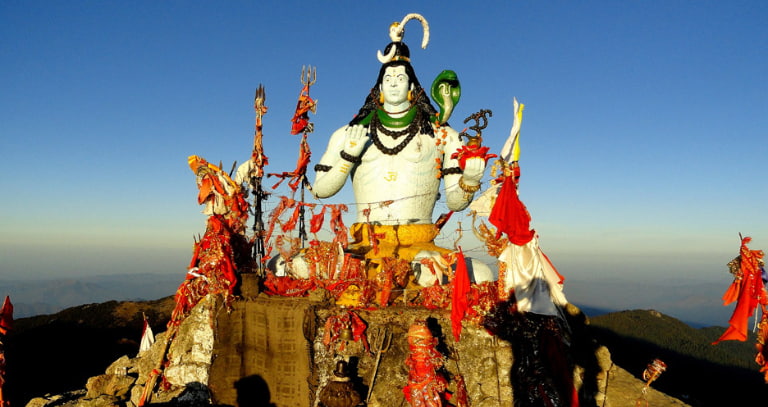
| Temple Name | Churdhar Temple |
| Location (District) | Sirmaur (Outer Himalayas) |
| Altitude | 3,647 m |
| Trek Distance | 16 km from Nauradhar |
| Main Significance | Lord Shiva meditated here; abode of 84 Siddhas |
| Unique Feature | Annual “Churdhar Jatra” festival |
| Best Time to Visit | June–July, Sept–Oct |
Conclusion
The Shiva temples of Himachal Pradesh represent more than places of worship; they are the symbols of the region’s devotion, focus, and heritage. Surrounded by the stunning beauty of the Himalayas, these temples provide a peaceful and spiritual environment that touches every visitor’s heart. Every temple, whether well-known or hidden, will reveal a story of faith and divine force. If you’re a peace seeker or just wish to connect more intimately with nature or the culture of the region, these temples will be a good place to visit. So next time you are thinking about making a trip to Himachal Pradesh, consider adding these alluring Shiva temples to the list of places you must visit.
Also Read – Top 10 Best Cafes in Jibhi
